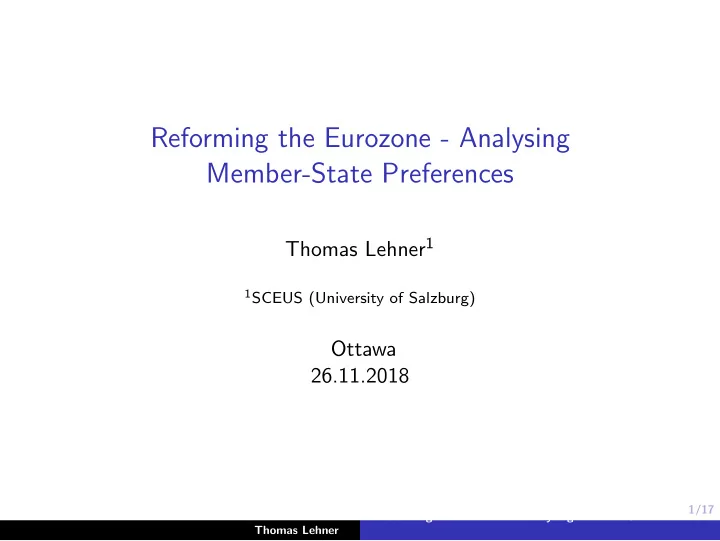

Reforming the Eurozone - Analysing Member-State Preferences Thomas Lehner 1 1 SCEUS (University of Salzburg) Ottawa 26.11.2018 1/17 Reforming the Eurozone - Analysing Member-State Preferences Thomas Lehner
Presentation outline ◮ About the project ◮ Data collected by the project ◮ Analysing Member-State Preferences 2/17 Reforming the Eurozone - Analysing Member-State Preferences Thomas Lehner
About the Project EMU Choices (.eu) ◮ June 2015 - June 2019 ◮ Nine teams (Salzburg, Grenoble, Dublin, East Anglia, CEU, Stockholm, LUISS, ETH and Konstanz) Research Questions ◮ Which member states pushed for monetary, economic and fiscal integration, and why? ◮ What kind of economic and political integration model was advocated, and by which member state? ◮ How and to what extent did political economy interests drive member states’ preferences? ◮ Did international pressure and constitutional constraints influence governments’ preference formation? 3/17 Reforming the Eurozone - Analysing Member-State Preferences Thomas Lehner
Research structure 5 research clusters ◮ Cluster 1: Case Studies ◮ Cluster 2: Quantitative Studies ◮ Cluster 3: Feasibility and dissemination ◮ Cluster 4: Theory ◮ Cluster 5: Legal 4/17 Reforming the Eurozone - Analysing Member-State Preferences Thomas Lehner
Data 3 data frames ◮ EMU Historical ◮ EMU Formation ◮ EMU Position 5/17 Reforming the Eurozone - Analysing Member-State Preferences Thomas Lehner
EMU Position 5-Step Data Collection Process ◮ policy proposals officially negotiated during the Eurozone crisis ◮ contested policy issues within these proposals. ◮ coding of preferences of all 28 EU member states and six EU institutions ◮ validation interviews ◮ aggregation 6/17 Reforming the Eurozone - Analysing Member-State Preferences Thomas Lehner
EMU Position 10 Policy proposals ◮ Assistance to Greece, EFSF, ESM ◮ SixPack, Two-Pack, Fiscal Compact ◮ FTT, Eurobonds, 5-Presidents Reports ◮ Banking Union 7/17 Reforming the Eurozone - Analysing Member-State Preferences Thomas Lehner
EMU Position 47 most contested issues ◮ they cover policy conflicts related to one of the ten selected reform proposals ◮ identifiable in the available primary and secondary sources ◮ validated by experts 8/17 Reforming the Eurozone - Analysing Member-State Preferences Thomas Lehner
Coding of preferences Wasserfallen, Fabio, et al. ”Analysing European Union Decision-Making during the Eurozone Crisis with New Data.” European Union Politics 20.1 (2018). 9/17 Reforming the Eurozone - Analysing Member-State Preferences Thomas Lehner
How to use this data? ◮ What explains these positions? ◮ Which country was most successful? ◮ Explaining decision-making during the Eurozone ◮ Underlying dimensionality of political conflict 10/17 Reforming the Eurozone - Analysing Member-State Preferences Thomas Lehner
What is structuring political conflict over EMU reform? Possible underlying dimension ◮ More vs. Less integration ◮ Left vs. Right ◮ Fiscal disciplin vs. fiscal redistribution ◮ Or a combination of those? Questions ◮ One, two or multidimensional conflict? ◮ Which conflict dimension(s) explain(s) the identified underlying conflict structure? ◮ For which policies do we observe deviant conflict structures? 11/17 Reforming the Eurozone - Analysing Member-State Preferences Thomas Lehner
Method Assumption ◮ Member states have an ideal point ◮ Ideal point structures their preferences ◮ Can be estemated Dimension reduction methods ◮ W-Nominate ◮ Bayesian Ordinal Item Response Theory ◮ Basic Space Scaling (Robustness Check) 12/17 Reforming the Eurozone - Analysing Member-State Preferences Thomas Lehner
How many underlying dimensions? Lehner/Wasserfallen. ”Political Conflict in the Reform of the Eurozone.” European Union Politics 20.1 (2018). 13/17 Reforming the Eurozone - Analysing Member-State Preferences Thomas Lehner
One-dimensional IRT Lehner/Wasserfallen. ”Political Conflict in the Reform of the Eurozone.” European Union Politics 20.1 (2018). 14/17 Reforming the Eurozone - Analysing Member-State Preferences Thomas Lehner
Where it does not fit: ◮ Specific economic interest ◮ Forward looking proposals ◮ Legal constraints and traditions ◮ Technocratic governments 15/17 Reforming the Eurozone - Analysing Member-State Preferences Thomas Lehner
Conclusion ◮ One dimensions structures EMU conflict ◮ Not restricted to one issue area of EMU ◮ Pivotal role of Eastern MS ◮ Important role of coalition leaders - France and Germany 16/17 Reforming the Eurozone - Analysing Member-State Preferences Thomas Lehner
Thank you! 17/17 Reforming the Eurozone - Analysing Member-State Preferences Thomas Lehner
Recommend
More recommend